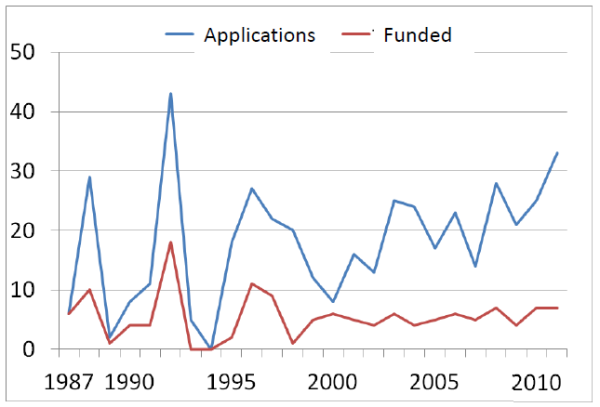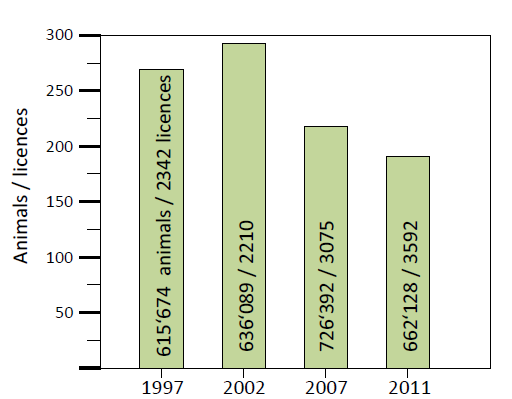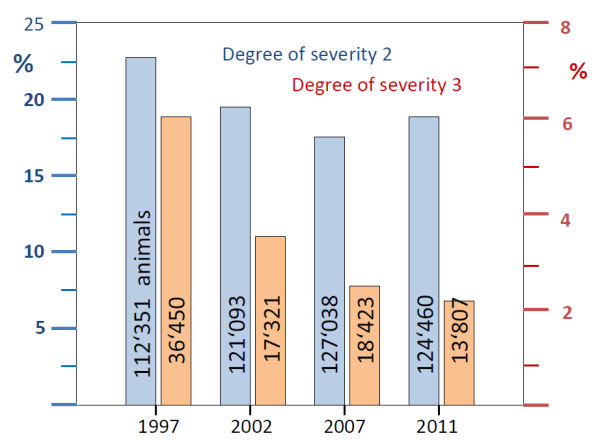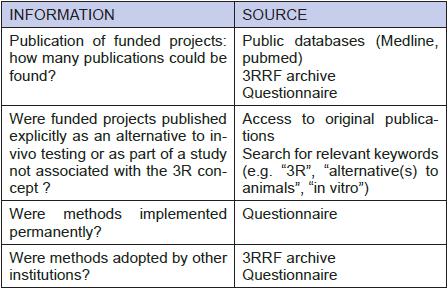 |
3R-INFO-BULLETIN 50
December 2012
Author

Peter Maier
Address:
peter.maier@uzh.ch or peter_maier@bluewin.ch
Scientific Advisor
University of Zürich
European Registered
Toxicologist
Alte Sulzbacherstrasse 22
CH-8610 Uster
Switzerland
Editor
Peter Maier, Scientific Advisor of the 3R Research Foundation (2000-2012)
Still relevant twenty-five years on
Prof. Dr. Peter Maier, Scientific Advisor of the 3R Research Foundation Switzerland (3RRF) and president of the Evaluation Committee, reflects on the visibility, activity and future role of the Foundation twenty-five years after its creation. Prof. Maier will retire at the end of 2012.
In the course of his twelve years of activity on behalf of the Foundation, he assessed 157 pilot projects, evaluating 252 applications together with the 3RRF Evaluation Committee; monitoring 63 projects supported by 3RRF; and providing success reports in 37 issues of 3R Info Bulletin and in 83 on-line updates and expanded abstracts.
The 3R Research Foundation (3RRF) is a Founder Member of the European Consensus Platform for 3R Alternatives created in 2001; 3RRF was involved in the EU project, Start Up (FP 7 Grant No 201187); in 2007 we produced the brochure, "Good Science with Less Animals" and in 2007 and 2012 co-organised joint anniversary conferences with the Swiss Laboratory Animal Science Association.
Visibility of the 3RRF
A recent survey showed that 70% of future directors of animal experiments to be conducted in Switzerland have heard of the 3R Research Foundation Switzerland (3RRF) and 60% of them have visited the 3RRF website. Half of them became aware of the Foundation in the context of their continuing professional education; 31% learnt about 3RRF from their colleagues; 15% found it on the internet, or through their involvement in college or university education (4%). Half of the future directors who had not (yet) heard of the Foundation had been working in Switzerland for less than two years.
Current situation
Over the past years we have seen a significant increase in the number of funding applications with a high relevance to the 3Rs. Life science research projects that enjoy the support of the Foundation aim to reduce the number of laboratory animals; to refine methods in justifiable animal experiments; and/or to replace experiments involving animal testing. Regrettably, funding has not been able to keep up with the increasing number of applications for 3R relevant projects. Hence, in the period of 2011 2012, the Foundation was able to provide support to just over one fifth of all projects for which applications had been submitted, compared to a previous average of 35% (Figure 3).

Fig 3
Number of applications and projects funded by 3RRF, from 1987 until 2011.
Average acceptance rate was 30%. Annual contributions fluctuated between CHF 700,000 and CHF 900,000 (approx. € 750,000). From 2009 until 2011 the number of applications deemed worthy of support increased whereas financial contributions remained constant. (4)
Twenty five years of activity also means that a new generation of researchers committed to the 3R principles has emerged. Their funding applications give evidence of the global acceptance of these principles, and how and to what purpose they can be implemented. The project leaders' outstanding qualifications also demonstrate that, over the past quarter of a century, the implementation of the 3R principles has become an integral part of innovative research.
Is specific support of the 3Rs still needed?
Why should there still be a need, after twenty-five years, for a foundation dedicated to supporting the implementation of the 3Rs in biomedical research? Established research promotion assesses and supports projects that aim to gain new insights. However, the responsibility for how this gain is achieved remains with the researcher. Any researcher who decides to abandon established procedures because they can see a way to reduce the number of laboratory animals, and/or the degree of pain and stress imposed on them, first has to explore the effects and impacts of the new 3R-relevant methods. A researcher exploring a study design that does not involve animals (often using human tissue instead) usually has to embark on a completely new pathway. Virtually all such innovations require additional funding while any knowledge gain remains in the balance. The 3R Research Foundation can step into this breach.
The 3Rs are an integral part of research involving laboratory animals
In established research promotion, research methods are a means to gaining new knowledge and insights; far less consideration is afforded to the actual development of research methods. In fact, the commonly used term of "3R-methods" means "3R-relevant methods", which also have to satisfy the highest scientific criteria. Traditional research promotion does not usually involve additional or ring-fenced funding for the development of 3R-relevant research methods.
Reduce: Any serious director of experiments involving animals will explore ways to reduce the number of animals required for their study, and will do so before embarking on the experiment. New methods (e.g. new imaging techniques) often lead to a significant reduction in the number of animals involved. The trend is also reflected in animal experiment statistics (1) where the number of animals used per experiment has diminished over the past ten years (Figure 1).

Fig 1
Decline in number of animals / licences from 2002 until 2011.
Data derived from animal use statitics published by the Swiss Federal Veterinary Office. (1)
Refine: A conscientious researcher will always ask whether the hoped-for knowledge gain could be achieved by using a method that would reduce the extent and duration of pain and stress imposed on laboratory animals. Again, it is a trend reflected in statistics that show a reduction in the number of animals subjected to high degrees of pain and stress (Figure 2).

Fig 2
Decline of retrospective degree of severity 3 (severe/short or moderate/longterm experience of pain and distress) from 1997 until 2011.
In percentages of all animals used (absolute numbers in the colums) Data derived from animal use statitics published by the Swiss Federal Veterinary Office. (1)
Refinement is not a synonym for "good veterinary-medical practice" (e.g. aseptic surgical techniques, adequate assessment of pain and pain relief). The latter is assumed in any animal intervention, for which Swiss legislation obliges project leaders and animal experimentators and researchers to acquire specific training and (continuing) education. Reduction and Refinement can often be achieved in the context of good animal research practice without requiring additional funding.
Replace: Many members of the general public wish to see a specific reduction in the number of animals used in research and laboratory testing. This can be achieved with all 3Rs. However, might people mistakenly equate the 3Rs to Replacement methods? While few in vitro experiments result in one-to-one replacement, the objective is also achieved when in vitro experiments render animal experiments superfluous. Many replacement methods are developed when researchers explore a completely new approach based on cells, tissues or isolated organs (e.g. using brain slices, or defining bacterial virulence in cell cultures, etc.), most of which require substantial additional efforts and funding.
Successful applications and projects
(see http://www.forschung3r.ch/en/projects/index.html)
With the exception of demonstrating 3R-relevance, there is little difference in the quality and scientific merit of funding applications submitted to the 3R Research Foundation Switzerland or to the Swiss National Science Foundation (SNF). Successful replacement-oriented applications tend to be submitted by researchers who are intimately familiar with animal experimentation. A successful applicant will demonstrate their extensive knowledge of the mechanisms involved in their particular research project. Numerous project leaders who have received 3RRF funding have received SNF funding also; many of them are involved in European research projects. Researchers will implement newly-developed 3R-relevant methods in their own fields. Once they have been published in peer reviewed journals, such methods may ideally inspire and provide an incentive for similar developments in other fields.
Outlook
After a dramatic reduction in the number of animals used for experimentation between 1987 and 2000, the numbers have levelled off (1), and have even increased for biomedical research in academic institutions, while in the private sector fewer animals are being used than ever before. If the development and improvement of 3R-relevant research methods is to be sustained, established research promotion needs to provide additional ring-fenced funding for projects that propose and describe a 3R-relevant improvement. Researchers who apply to the Foundation demonstrate their commitment to the 3R cause. 134 projects supported by 3RRF in the course of the past twenty-five years are a testament to the existence of alternative and unconventional ideas in virtually every field of biomedical research. In short: 3R = Better Science.
Has the 3R Research Foundation been successful in the past quarter century? How do we measure success? What needs to be done in the next twenty-five years? Please read the following article.
PDF version of this Bulletin No. 50
References:
Author

Stefanie Schindler
Address:
Scientific Advisor
Animalfree Research (AfR)
Postgasse 15
CH-3011 Bern
Switzerland
25 years of Funding the 3Rs – past accomplishments and future prospects
Since 1987 the 3R Research Foundation Switzerland (3RRF) has funded a total of 134 3R relevant projects, investing over 17 million Swiss francs (approx. 14 million Euros). On the occasion of its twenty-fifth anniversary, it was decided to produce an overview and to evaluate the projects funded between 1987 and 2011, including their overall performance and 3R relevant impact.
The following presents the preliminary findings of a study carried out by Dr. med. vet. Dr. rer. nat. Stefanie Schindler, scientific advisor to the Animal free Research Foundation (AfR) and an Animal Welfare expert. Dr. Schindler is a member of the 3RRF Evaluation Committee.
Seventeen million Swiss francs invested
According to its Charter of 1987, the 3R Research Foundation Switzerland (3RRF) promotes alternative methods to animal experimentation through grants for research projects as well as the implementation and promotion of the 3R principles as described by Russell and Burch. (1) Most project proposals selected for funding are related to life sciences including drug development, an area that involves some sixty per-cent of all laboratory animals used in Switzerland. In this country, about ten to fifteen per-cent of laboratory animals are used in toxicity and safety testing of chemicals and pharmaceutical products. Sixteen projects (12%) were funded in this area (hazard identification, refinement of protocols, quality control), demonstrating a clear preferential allocation of seventeen million Swiss francs to life sciences, albeit in proportion to the use of animals. The duration of individual projects varied between one and five years; the total cost per project ranged from approx. CHF 30,000 to CHF 260,000. The relationship of the number of applications to approved projects over twenty-five years is provided in Figure 3. Of the 134 projects, only four had to be aborted yielding no results. (3%)

Fig 3
Number of Applications and projects funded by 3RRF, from 1987 until 2011.
The average acceptance rate was 30%. Annual contributions fluctuated between CHF 700’000 and CHF 900’000 (approx. € 750’000). From 2009 until 2011 the number of applications deemed worthy of support increased whereas the finacial contributions remained constant. (4)
Assessment of twenty-five years of funding
On the occasion of the Foundation's twenty-fifth anniversary, a study was initiated to assess the type of projects supported by 3RRF, and to evaluate their impact on animal experimentation, particularly in terms of the 3R principles as outlined in the project proposals. The study is also intended to examine both the strategy applied so far, and the performance and efficiency of the funding procedure.
The study was carried out in two steps. Firstly, 130 projects approved by the Foundation prior to the end of 2011 were assessed in terms of general categorisation, e.g. concerning costs, duration, type of participating institution(s), main animal species concerned and main "3R aspect" (replacement, reduction, refinement). The second part of the study, which is in progress, will evaluate the practical impact of project results. Criteria were developed for this purpose (Table 1) and the projects are being evaluated accordingly.

Tab 1
Where to obtain data (examples)
The study’s approaches are guided by examples provided in the NC3R evaluation framework. (2)
Heterogeneous material
3RRF funding policy has been based on proposals from all types of research areas, the original rationale being that the researchers themselves are best qualified to define the procedures in need of urgent improvement with regard to the 3Rs. According to the 3RRF website and considering the 120 keywords defined by the Foundation, the 130 projects focus on more than twenty organisms and 38 different types of organs and cells. Projects derive from twenty-four different research areas dealing with twenty-one diseases and using nineteen different methods. Twelve different types of cell culture were described. Most projects can be assigned to more than one of the 3Rs. In total, some fifty to sixty per-cent of the projects can be attributed to Replacement, either in part or in full. Seventy per-cent of the funded projects derived from universities.
Time-dependent changes
In order to attempt to define time dependent trends within the twenty-five year period, the evaluation focused on two clusters of twenty-five projects each, with one cluster funded in the period from 1987 until 1992, and the other from 2003 until 2008.
How should 3R relevance be measured?
This question was approached by a previously defined catalogue of criteria, of which the following were found to be suitable:
- reduction of animal numbers
- reduction of severity degree
- publications and citations, with a specific focus on specific mention of the 3R concept
- implementation of a newly developed method
- adoption of a method by other working groups
- adoption into national/international animal welfare regulation/legislation
- other impacts, e.g. increased awareness of the existence and importance of alternatives to animals
Source of data – some limitations
Information about the projects discussed in this study (Table 1) draws on various sources, e.g. the 3RRF archive (extended abstracts, project leaders' annual and final reports, internal critical assessments by the 3RRF Scientific Board as reported to the Administrative Board), searches of public databases (life sciences), and a questionnaire sent out to project leaders.
However, especially for the 1987-1992 cluster, it has proved impossible to gather complete information on a given project, even though we have made use of all available documentation. This is in part due to the time that has elapsed, and in part to the complexity of the topic. For example, it has proven an elusive task to trace every laboratory that has adopted one or another method funded by the 3RRF at one or another point in time – often quite simply because some laboratories no longer exist.
Any statements concerning the scientific and practical impact of a given method as illustrated in the study will therefore represent "minimum data" only; in other words, we have only used figures and details of reliable provenance, and confirmed by a source that is still in existence.
Between facts and wishful thinking
To the best of our knowledge, this is the first time that a systematic quantitative assessment regarding the 3R impact of project work predominantly in the field of life sciences has been attempted. A former study in Germany concluded that it was not a reasonable objective to provide quantitative or semi quantitative estimates of animal numbers, for example. (3)
In fact, some issues with this type of analysis might prove to be insurmountable. For one thing, numbers provided at the time cannot be extrapolated into an indefinite future. Also, it is virtually impossible, for example, to reliably say how many experimental animals were saved by the projects funded by 3RRF, even in the ideal case where, i) the new method is aimed at replacement and permits an immediate switch from in-vivo to in-vitro in a particular research area, and where, ii) we have access to reliable documentation concerning animal numbers before and after implementation of the 3R-relevant method. Likewise, since the number of experiments using the often quicker, easier and cheaper in-vitro method tends to increase, resulting numbers of saved animals cannot provide reliable information. Hence, the number of in-vitro experiments is an unreliable parameter for the calculation of animal numbers. At best, the present study can provide minimum numbers, and will certainly tend to underestimate the achievements of the projects.
The next stage
The study has now entered its second stage, which will address the projects' overall impact on the 3Rs. We will interview former project leaders who may provide a retrospective analysis regarding the impact of their work. Completion of the study is expected by spring 2013. The 3R Research Foundation Switzerland will publish the report on its website soonest.
PDF version of this Bulletin No. 50
References:
- Russell WMS, Burch RL. The Principles of Humane Experimental Technique. Methuen: London, 1959; reprinted by UFAW, 1992: 8 Hamilton Close, South Mimms, Potters Bar, Herts EN6 3QD, England
- www.nc3rs.org.uk/document.asp?id=1810
- publica.fraunhofer.de/dokumente/N 198814.html (in German only)
- www.forschung3r.ch/en/information/jb11.html
| Dernières modifications: 07.01.2013 |